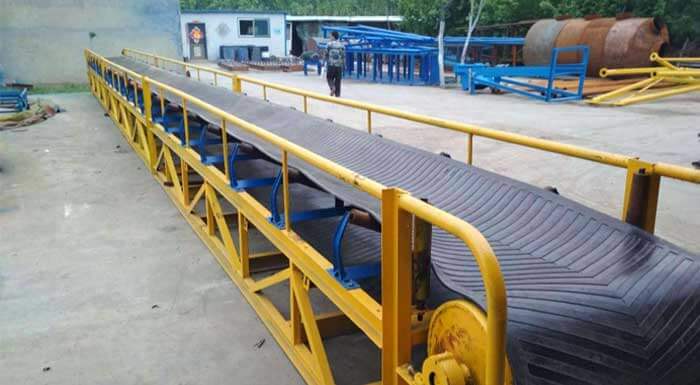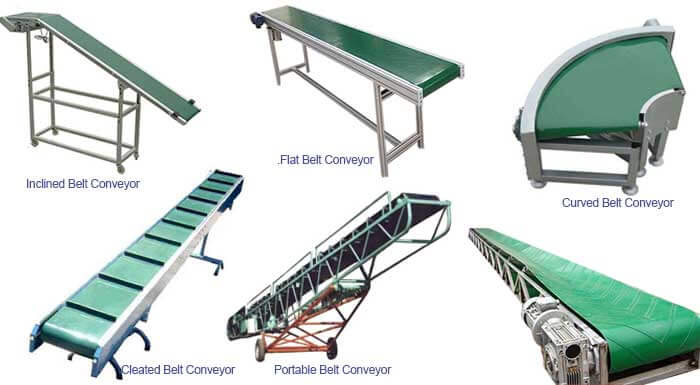16 Methods Help To Solve Belt Conveyor Deviation Problem
Belt conveyor deviation is a common fault during the operation of the belt conveyor. Long term deviation not only causes severe wear on the edges of the conveyor belt, but also leads to sudden accidents such as conveyor belt tearing and scraping. This article shares 16 methods to solve the problem of belt deviation in belt conveyors.

1. Adjusting Deflection Roller
When the deviation range of the belt conveyor is not too large, the groove type deviation adjustment roller can be used for automatic adjustment. When the conveyor belt deviates, it touches the stop roller on the groove type adjustment roller. Due to the friction between the stop roller and the edge of the conveyor belt, it moves forward along the direction of the conveyor belt, while the other side moves relatively backward. At this point, the conveyor belt moves towards the side of the reverse roller until it returns to its normal position.
2. Gravity Deviation Adjustment
If the conveyor belt runs under heavy load and deviates, the drum and support roller of the conveyor belt can be appropriately raised, so that the material on the conveyor belt generates a component force to prevent the conveyor belt from deviating, until the conveyor belt returns to its normal position.
3. Vertical Roller Deviation Adjustment
If the conveyor belt always deviates to one side during operation, the support roller can be vertically installed (vertical roller) on the deviation side of the conveyor belt. This way, on the one hand, the force of the vertical roller causes the conveyor belt to forcibly reset.
On the other hand, due to the friction between the vertical roller and the edge of the conveyor belt , the linear speed of the conveyor belt on the deviation side is reduced, and the linear speed on the other side of the conveyor belt is relatively increased, causing the conveyor belt to move towards the other side until it resets.
4. Boosting Bracket
If the conveyor belt always runs off to one side during idle operation, the opposite side of the support roller can be appropriately raised. The front and rear height arrays should be based on the first raised support roller. Slowly reduce the height of the raised support roller, and the deviation of the conveyor belt will disappear.
5. Roller Cleaning
If the conveyor belt runs off at a fixed point and remains fixed, it is necessary to check whether the roller at this point has stopped rotating, stuck mud, etc., causing changes in the diameter of the roller or detachment of the roller, and take corresponding measures.

6. Adjust Tensioning Sevice
If the conveyor belt machine runs left and right without a fixed direction, it indicates that the conveyor belt is loose. The tensioning device should be adjusted to tighten the conveyor belt, and the deviation will disappear.
7. Narrow Conveyor Belt Deviation Adjustment
If the conveyor belt deviates from the head or tail during operation, the parallelism error of the head and tail drums should be eliminated first. Then, on the other side of the drum that deviates from the head or tail, a narrow conveyor belt of 200mm x 200mm should be used to clamp it into the drum and rotate it together with the drum
When adjusting using this method, the conveyor belt will move to the other side until it reaches the normal position, and then remove the narrow conveyor belt. The conveyor belt machine will operate normally.
8. Adjusting Deviation of Rolling Cylinder
If the conveyor belt deviates at the drum, it indicates horizontal movement, sticky material (causing the drum diameter to increase or decrease), or installation errors during drum rotation. The levelness and parallelism of the front and rear drums should be corrected according to the situation, and the deviation will disappear.
9. Reduce Resistance
If the deviation of the conveyor belt is not too serious, the roller on the side of the conveyor belt deviation should be cleaned and a few drops of mechanical oil should be dropped on the roller bearing to reduce the friction resistance of the roller rotation and accelerate the angular velocity of the roller rotation, which can eliminate the deviation of the conveyor belt.

10. Material Flow Correction
If the conveyor belt runs without deviation during idle operation and deviates during heavy load operation, it indicates that the material is unevenly distributed on both sides of the conveyor belt and the loading funnel is not correct. The funnel should be calibrated or a guide plate should be installed in the funnel to change the angle of material falling, in order to adjust the direction of material flow at any time and ensure even distribution of materials on both sides of the conveyor belt.
11. Joint Calibration
If the conveyor belt always deviates to one side during operation, and the maximum deviation happens to be at the joint, and the deviation position is not fixed, it indicates that the conveyor belt joint is not correct. The incorrect belt adhesive head should be cut off and remade.
12. Bracket Calibration
If the conveyor belt deviates significantly to the same side and is in a certain position during operation, it indicates that the roller support or frame is twisted improperly. The levelness and verticality of the support or frame should be corrected, and the severely twisted roller support should be replaced.
By reinstalling the rack and ensuring that the centerline and sides of the rack are flat, the problem can be fundamentally solved.
13. Conveyor Belt Repair
If the edge of the conveyor belt is severely worn, causing uneven tension on both sides of the conveyor belt and the conveyor belt to deviate from its fixed position, the conveyor belt should be repaired or replaced with a new one in a timely manner according to the actual situation.

14. Adjusting Support Roller Deviation
If the conveyor belt always deviates to one side when unloaded, three of the four fixed bolts connecting a set of roller supports to the frame can be removed at the center position of the conveyor belt deviation side, leaving one axle.
When the conveyor belt deviates from the side where the person is standing, the bracket can be moved forward at an appropriate angle along the direction of the conveyor belt movement; On the contrary, when the conveyor belt deviates towards the other side, the bracket can be moved at an appropriate angle against the direction of the conveyor belt, and then fixed, and the deviation will naturally disappear.
15. Tensioning Device
If the conveyor belt deviates to the same side during both unloaded and overloaded operation, it indicates that the degree of tightness on both sides of the conveyor belt is different. The tension devices such as screw rods or counterweights at the front and rear rollers should be adjusted.
16. Add Pressure Rollers
It is best to add a pressure pulley at the concave section of the belt conveyor to avoid the belt bouncing or being blown off by the wind. During the design phase, a larger curvature radius of the concave section should be used as much as possible to avoid such situations.
 Hot 10 Types of Belt Conveyor Troubleshootings
Hot 10 Types of Belt Conveyor Troubleshootings 10 Belt Conveyor Types & 5 Types of Conveyor Belt Materials
10 Belt Conveyor Types & 5 Types of Conveyor Belt Materials Conveyor Belt Working Principle & Application
Conveyor Belt Working Principle & Application 10+ Tips Help To Select A Right Conveyor Belt
10+ Tips Help To Select A Right Conveyor Belt



